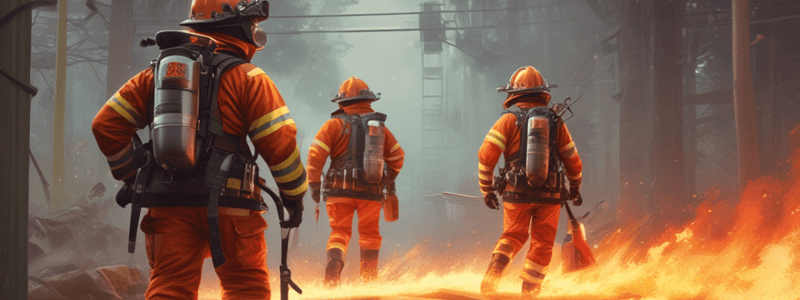Podcast
Questions and Answers
What is the primary purpose of the Standard Operating Guideline on Extreme Temperature?
What is the primary purpose of the Standard Operating Guideline on Extreme Temperature?
- To maintain records of temperature-related incidents
- To ensure the safety of members during training in extreme temperatures (correct)
- To provide guidelines for indoor training during extreme temperatures
- To establish a maximum limit for outdoor training exercises
What maximum Heat Index allows for drills and training to proceed as normal?
What maximum Heat Index allows for drills and training to proceed as normal?
- Heat Index of 90
- Heat Index of 100
- Heat Index of 85 (correct)
- Heat Index of 95
What action should be taken when the Heat Index reaches 101 or greater?
What action should be taken when the Heat Index reaches 101 or greater?
- Drills should be planned for indoor settings automatically
- All outdoor training must be canceled immediately
- Training must continue without any interruptions
- Contact the Battalion Chief-Training/Safety for guidance (correct)
What combination of factors forms the Apparent Temperature or Heat Index?
What combination of factors forms the Apparent Temperature or Heat Index?
What should be done when the Heat Index ranges from 86 to 100?
What should be done when the Heat Index ranges from 86 to 100?
Which tool is recommended for assessing current heat index conditions?
Which tool is recommended for assessing current heat index conditions?
In what year is the next re-evaluation of the Standard Operating Guideline scheduled?
In what year is the next re-evaluation of the Standard Operating Guideline scheduled?
Under what conditions is outdoor activity considered dangerous for members?
Under what conditions is outdoor activity considered dangerous for members?
During training, if full protective clothing (Turnout coat & pants, helmet, hood and gloves) is worn, what adjustment should be made to the environmental temperature before calculating the Heat Index?
During training, if full protective clothing (Turnout coat & pants, helmet, hood and gloves) is worn, what adjustment should be made to the environmental temperature before calculating the Heat Index?
What is the recommended fluid intake during training in warm weather conditions?
What is the recommended fluid intake during training in warm weather conditions?
Which of the following is NOT an alternative to consider when the extreme heat policy is in effect?
Which of the following is NOT an alternative to consider when the extreme heat policy is in effect?
What are the potential life-threatening conditions caused by overheating?
What are the potential life-threatening conditions caused by overheating?
What is the primary concern regarding extreme heat during training?
What is the primary concern regarding extreme heat during training?
Which of the following is NOT a key rule to remember when coping with extreme heat?
Which of the following is NOT a key rule to remember when coping with extreme heat?
What is the acronym used in the document to refer to the Temperature Humidity Index?
What is the acronym used in the document to refer to the Temperature Humidity Index?
What is the primary message conveyed by the document?
What is the primary message conveyed by the document?
Flashcards are hidden until you start studying
Study Notes
Purpose of Guidelines
- Ensure safety of Hoffman Estates Fire Department (HEFD) members during training in extreme temperatures.
Extreme Temperatures
- High temperatures with high relative humidity combine to form the Apparent Temperature or Heat Index.
- Heat Index is calculated using shaded, light wind (5MPH) conditions.
- OSHA-NIOSH Heat Safety Tool App is used to determine real-time heat index and hourly forecasts specific to the location.
Policy for Training in Extreme Temperatures
- Heat Index of 85 and under: Drills and training shall proceed as normal.
- Heat Index of 86 to 100: Caution and reservation shall be used in continuing, planning, or completing outside training.
- Heat Index of 101 or greater: The Battalion Chief-Training/Safety (or other staff officer available) shall be contacted to determine if outside training can continue.
Adjustments for Protective Gear
- If full protective clothing is worn, add 10 degrees to the environmental temperature before calculating the Heat Index.
- If partial turnout gear is worn, add 5 degrees to the environmental temperature.
Hydration and Health
- Members should pre-hydrate and post-hydrate during training in warm weather conditions.
- Drink 7 oz. of fluid every 20 minutes to stay hydrated.
- Alternatives to consider when policy is in effect include:
- Having drills in morning or evening hours
- Rescheduling drills to another day
- Conducting drills inside
- Not wearing turnout gear during drills if possible
- Providing a rehab facility at the drill site
Key Rules for Coping with Extreme Heat
- Drink plenty of water to avoid dehydration
- Slow down and cool off regularly
- If feeling fatigued, headache, elevated pulse rate, or shallow breathing, contact EMS personnel as soon as possible.
Studying That Suits You
Use AI to generate personalized quizzes and flashcards to suit your learning preferences.




